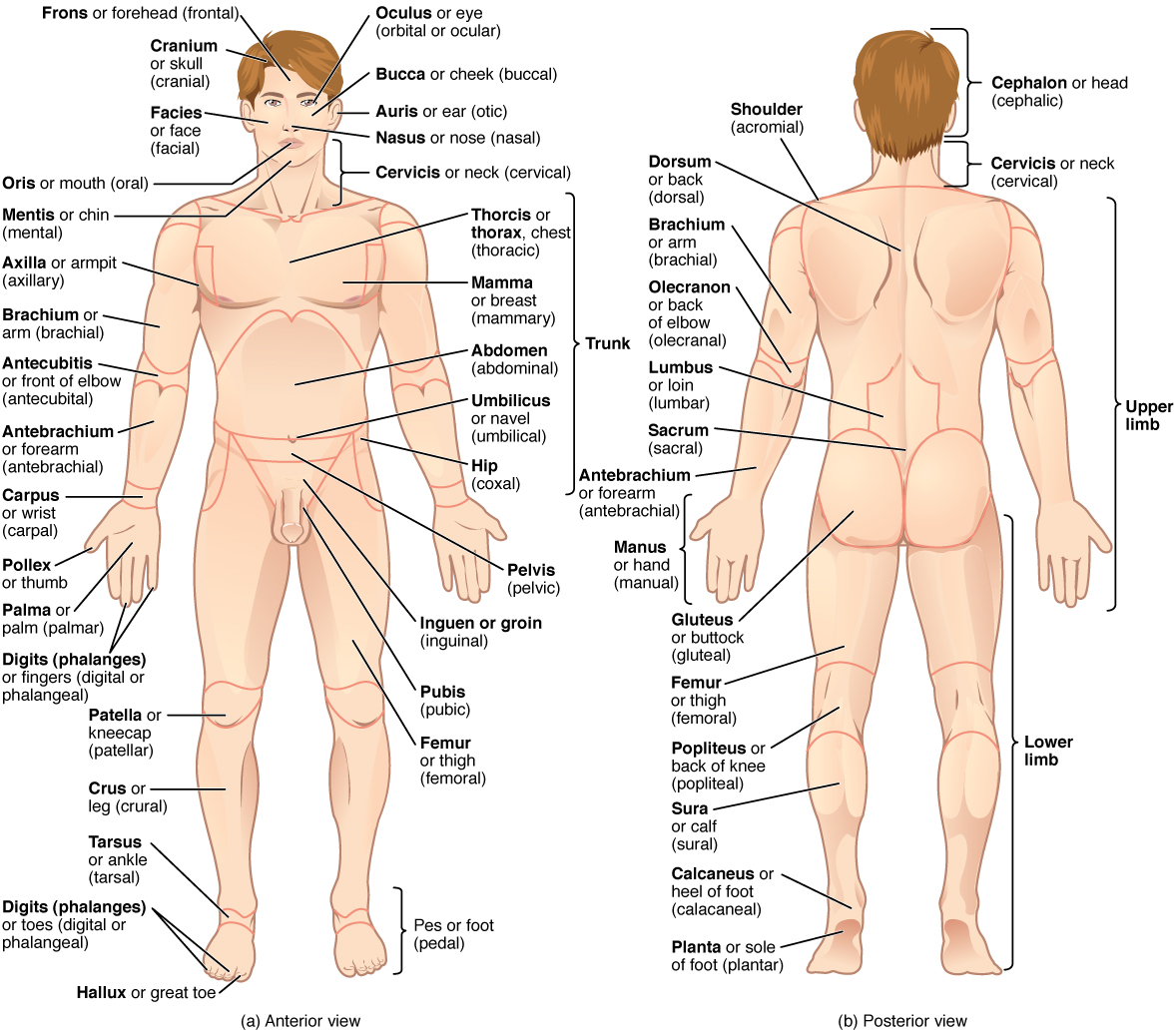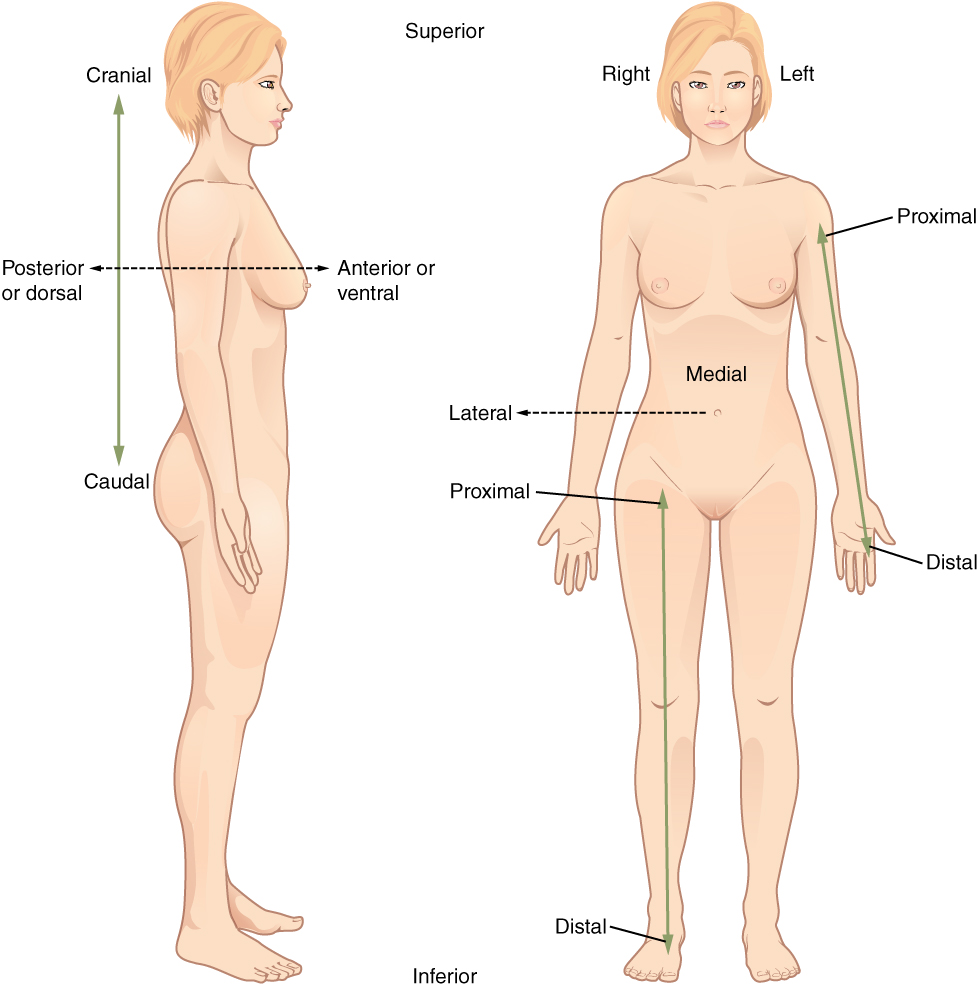2.2 – Anatomical Position
Watch Introduction to Anatomy & Physiology: Crash Course Anatomy & Physiology #1 (11 min) on YouTube
Media 2.1: CrashCourse. (2015, January 6). Introduction to anatomy & physiology: Crash Course anatomy & physiology #1 [Video]. YouTube. https://youtu.be/uBGl2BujkPQ
Anatomical Position
Anatomists and health care providers use terminology for the purpose of precision and to reduce medical errors. For example, is a scar “above the wrist” located on the forearm two or three inches away from the hand? Or is it at the base of the hand? Is it on the palm-side or back-side? By using precise anatomical terminology, we eliminate ambiguity. Anatomical terms derive from ancient Greek and Latin words.
To further increase precision, anatomists standardize the way in which they view the body. Just as maps are normally oriented with north at the top, the standard body “map,” or anatomical position, is that of the body standing upright, with the feet at shoulder width and parallel, toes forward. The upper limbs are held out to each side, and the palms of the hands face forward as illustrated.
Using this standard position reduces confusion. It does not matter how the body being described is oriented, the terms are used as if it is in anatomical position. For example, a scar in the “anterior (front) carpal (wrist) region” would be present on the palm side of the wrist. The term “anterior” would be used even if the hand were palm down on a table.
Did You Know?
Terminology is used for the purpose of precision and reduction of medical error.

A body that is lying down is described as either prone or supine. These terms are sometimes used in describing the position of the body during specific physical examinations or surgical procedures.
Regional Terms
The human body’s numerous regions have specific terms to help increase precision. Notice that the term “brachium” or “arm” is reserved for the “upper arm” and “antebrachium” or “forearm” is used rather than “lower arm.” Similarly, “femur” or “thigh” is correct, and “leg” or “crus” is reserved for the portion of the lower limb between the knee and the ankle. You will be able to describe the body’s regions using the terms from the anatomical position.
Directional Terms
Directional terms are essential for describing the relative locations of different body structures. For instance, an anatomist might describe one band of tissue as “inferior to” another or a physician might describe a tumor as “superficial to” a deeper body structure. Commit these terms to memory to avoid confusion when you are studying or describing the locations of particular body parts.
- Anterior (or ventral) describes pertaining to the front or direction toward the front of the body. The toes are anterior to the foot.
- Posterior (or dorsal) describes pertaining to the back or direction toward the back of the body. The popliteus is posterior to the patella.
- Superior (or cranial) describes pertaining to the position above or higher than another part of the body proper. The orbits are superior to the oris.
- Inferior (or caudal) describes a position pertaining to below or lower than another part of the body proper; near or toward the tail (in humans, the coccyx, or lowest part of the spinal column). The pelvis is inferior to the abdomen.
- Lateral describes the side or direction pertaining to toward the side of the body. The thumb (pollex) is lateral to the digits.
- Medial describes the middle or direction pertaining to toward the middle of the body. The hallux is the medial toe.
- Proximal describes a position pertaining to a limb that is nearer to the point of attachment or the trunk of the body. The brachium is proximal to the antebrachium.
- Distal describes a position pertaining to a limb that is farther from the point of attachment or the trunk of the body. The crus is distal to the femur.
- Superficial describes a position pertaining to closer to the surface of the body. The skin is superficial to the bones.
- Deep describes a position farther from the surface of the body. The brain is deep to the skull.

Medical Language within the Context of Anatomy and Physiology Directional Terms
Practice these directional terms.
Medical Language with the Context of Anatomy and Physiology Directional Terms (Text version)
- Cranial Cavity
- KRĀ-nē-ăl kah-vi-tē
- The space formed inside the skull that the brain occupies.
- Homeostasis
- HŌ-mē-ō-STĀ-sĭs
- Biological process that results in stable equilibrium
- Posterior (or Dorsal)
- pŏs-TĒ-rē-or(Original Term)
- Describes the back or direction toward the back of the body.
- Anterior (or Ventral)
- an-TĒR-ē-ŏr (Original Term)
- Describes the front or direction toward the front of the body.
- Deep
- DĒP (Original Term)
- Describes a position farther from the surface of the body.
- Distal
- DIS-tăl (Original Term)
- Describes a position in a limb that is farther from the point of attachment or the trunk of the body.
- Inferior (or Caudal)
- in-FĒR-ē-ŏr (Original Term)
- Describes a position below or lower than another part of the body proper; near or toward the tail.
- Lateral
- LĂT-ĕr- ăl (Original Term)
- Describes the side or direction toward the side of the body.
- Medial
- MĒD-ē-ăl (Original Term)
- Describes the side or direction toward the side of the body.
- Peritoneum
- (per-it-ŏ-NĒ-ŭm)
- Serous membrane surrounding several organs in the abdominopelvic cavity. This reduces friction between the abdominal and pelvic organs and the body wall.
- Proximal
- PROK-sĭ-măl (Original Term)
- Describes a position in a limb that is nearer to the point of attachment or the trunk of the body.
- Superficial
- SOO-pĕr-FISH-ăl (Original Term)
- Describes a position in a limb that is nearer to the point of attachment or the trunk of the body.
- Superior (or Cranial)
- soo-PĒ-rē-or(Original Term)
- Describes a position above or higher than another part of the body proper.
Activity Source: Medical Language with the Context of Anatomy and Physiology Directional Terms from Medical Terminology by Grimm et al., licensed under CC BY 4.0./Re-recording of some H5P audio by Tania Deane and David McCuaig and text version added.
Concept Check
- Find a partner and take turns choosing two body parts on your or your partner’s body.
- Using directional terms, describe the location of those body parts relative to one another.
Image Descriptions
Figure 2.4 image description: This illustration shows an anterior and posterior view of the human body. The cranial region encompasses the upper part of the head while the facial region encompasses the lower half of the head beginning below the ears. The eyes are referred to as the ocular region. The cheeks are referred to as the buccal region. The ears are referred to as the auricle or otic region. The nose is referred to as the nasal region. The chin is referred to as the mental region. The neck is referred to as the cervical region. The trunk of the body contains, from superior to inferior, the thoracic region encompassing the chest, the mammary region encompassing each breast, the abdominal region encompassing the stomach area, the coxal region encompassing the belt line, and the pubic region encompassing the area above the genitals. The umbilicus, or naval, is located at the center of the abdomen. The pelvis and legs contain, from superior to inferior, the inguinal or groin region between the legs and the genitals, the pubic region surrounding the genitals, the femoral region encompassing the thighs, the patellar region encompassing the knee, the crural region encompassing the lower leg, the tarsal region encompassing the ankle, the pedal region encompassing the foot and the digital/phalangeal region encompassing the toes. The great toe is referred to as the hallux. The regions of the upper limbs, from superior to inferior, are the axillary region encompassing the armpit, the brachial region encompassing the upper arm, the antecubital region encompassing the front of the elbow, the antebrachial region encompassing the forearm, the carpal region encompassing the wrist, the palmar region encompassing the palm, and the digital/phalangeal region encompassing the fingers. The thumb is referred to as the pollux. The posterior view contains, from superior to inferior, the cervical region encompassing the neck, the dorsal region encompassing the upper back and the lumbar region encompassing the lower back. The regions of the back of the arms, from superior to inferior, include the cervical region encompassing the neck, acromial region encompassing the shoulder, the brachial region encompassing the upper arm, the olecranal region encompassing the back of the elbow, the antebrachial region encompasses the back of the arm, and the manual region encompassing the palm of the hand. The posterior regions of the legs, from superior to inferior, include the gluteal region encompassing the buttocks, the femoral region encompassing the thigh, the popliteus region encompassing the back of the knee, the sural region encompassing the back of the lower leg, and the plantar region encompassing the sole of the foot. Some regions are combined into larger regions. These include the trunk, which is a combination of the thoracic, mammary, abdominal, naval, and coxal regions. The cephalic region is a combination of all of the head regions. The upper limb region is a combination of all of the arm regions. The lower limb region is a combination of all of the leg regions. [Return to Figure 2.4].
Figure 2.5 image description: This illustration shows two diagrams: one of a side view of a female and the other of an anterior view of a female. Each diagram shows directional terms using double-sided arrows. The cranial-distal arrow runs vertically behind the torso and lower abdomen. The cranial arrow is pointing toward the head while the caudal arrow is pointing toward the tail bone. The posterior/anterior arrow is running horizontally through the back and chest. The posterior or dorsal arrow is pointing toward the back while the anterior, or ventral arrow, is pointing toward the abdomen. On the anterior view, the proximal/distal arrow is on the right arm. The proximal arrow is pointing up toward the shoulder while the distal arrow is pointing down toward the hand. The lateral-medial arrow is a horizontal arrow on the abdomen. The medial arrow is pointing toward the navel while the lateral arrow is pointing away from the body to the right. Right refers to the right side of the woman’s body from her perspective while left refers to the left side of the woman’s body from her perspective. [Return to Figure 2.5].
Attribution
Except where otherwise noted, this chapter is adapted from “Medical Language Within the Context of Anatomy and Physiology” in Building a Medical Terminology Foundation by Kimberlee Carter and Marie Rutherford, licensed under CC BY 4.0. / A derivative of Betts et al., which can be accessed for free from Anatomy and Physiology (OpenStax). Adaptations: dividing Medical Language Within the Context of Anatomy and Physiology chapter content into sub-chapters.
is that of the body standing upright, with the feet at shoulder width and parallel, toes forward. The upper limbs are held out to each side, and the palms of the hands face forward (Betts, et al 2013)
face-down
face up

